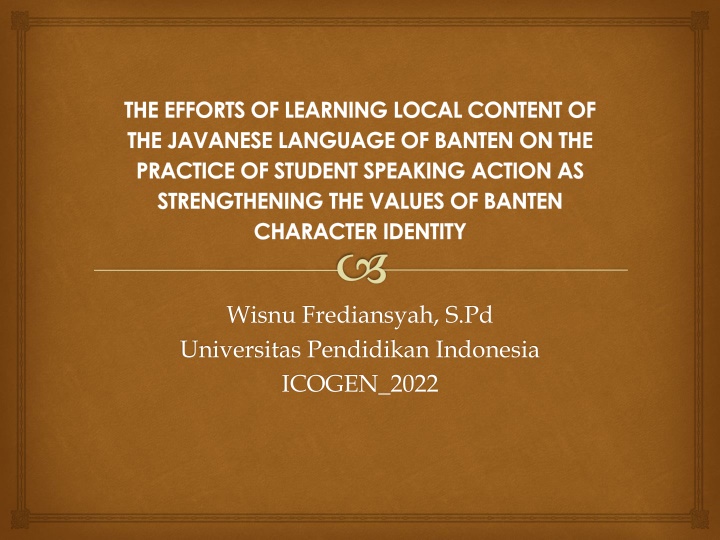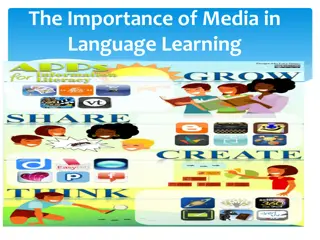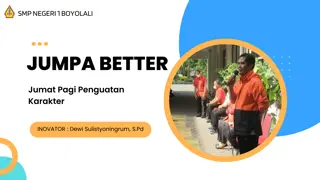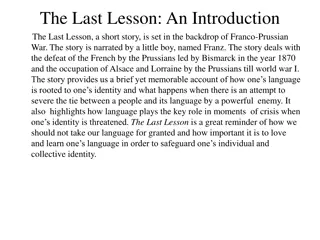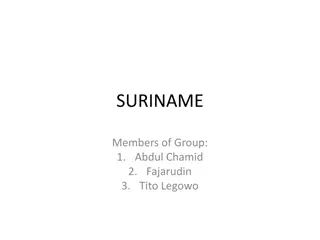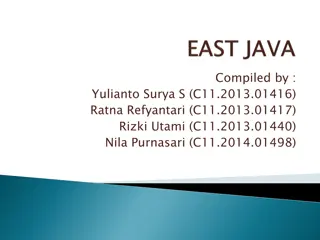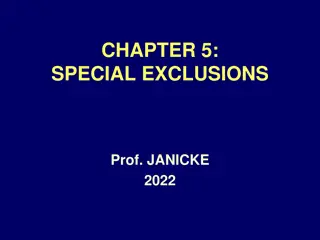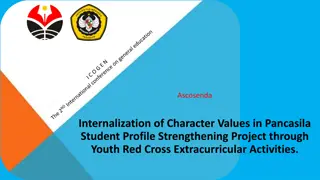Strengthening Banten Character Identity Through Javanese Language Learning
This research explores the impact of learning Javanese language in Banten on student speaking actions to enhance Banten's character identity. It discusses students' speech acts, teacher's role, and factors influencing local language learning.
Uploaded on Feb 28, 2025 | 0 Views
Download Presentation

Please find below an Image/Link to download the presentation.
The content on the website is provided AS IS for your information and personal use only. It may not be sold, licensed, or shared on other websites without obtaining consent from the author.If you encounter any issues during the download, it is possible that the publisher has removed the file from their server.
You are allowed to download the files provided on this website for personal or commercial use, subject to the condition that they are used lawfully. All files are the property of their respective owners.
The content on the website is provided AS IS for your information and personal use only. It may not be sold, licensed, or shared on other websites without obtaining consent from the author.
E N D
Presentation Transcript
THE EFFORTS OF LEARNING LOCAL CONTENT OF THE JAVANESE LANGUAGE OF BANTEN ON THE PRACTICE OF STUDENT SPEAKING ACTION AS STRENGTHENING THE VALUES OF BANTEN CHARACTER IDENTITY Wisnu Frediansyah, S.Pd Universitas Pendidikan Indonesia ICOGEN_2022
Introduction Character Education Character education through local languages Local subject in Banten Java language Politeness of speech acts
Formulation of the Problem How are students' speech acts in everyday behavior in the school environment? How is the teacher's ability to carry out the local subject of the Banten Java language in the application of speech act sensibility practices for students ? What are the supporting and inhibiting factors in learning local subject Banten Javanese language ?
Methods In this study, using descriptive qualitative research methods. The method used in this research is descriptive method, which is a research method aimed at describing existing phenomena. Qualitative method is a process of research and understanding based on a methodology that investigates a social phenomenon and human problem. In this approach, the researcher makes a complex picture, examines words, reports detailed views of the respondents, and conducts studies in natural situations(Cresswell, 2008: 15). This research was conducted at SD Negeri Taman Baru 2 in Taktakan sub-district, Serang City, where there was a local content learning of Banten, the reason the researcher chose SD Negeri Taman Baru 2 as the research site was because the dominant community around the school still used the Javanese Banten language as their daily language, as well as to help develop the ability of teachers in the working environment of researchers.
A. Tindak tutur peserta didik dalam perilaku sehari-hari di lingkungan sekolah In observations made by researchers, it appears that students often use swear words such as "Asu" to their friends, the use of the word "stupid" to insult their playmates and the use of animal names as insults to their friends, this indicates the absence of politeness. polite in the language of the speech that students remove from his mouth to his friends.
B. Student speech acts in everyday behavior in the school environment 1. Greet students in a friendly manner when entering the classroom to exemplify a polite attitude to students Greeting is an initial activity that is usually carried out by every teacher when entering the classroom as a preliminary activity before the teacher starts learning activities in the classroom. From the observations that the researcher has done, it can be seen that Mrs. Tuti is always used to greeting, hugging and giving warm smiles to students before entering the class. 1. 2. Habituation to provide an example regarding the use of the Java language Banten The habit of using the Javanese language of Banten is used by Mrs. Tuti every time she communicates in the school environment, according to her, giving an example of using the Javanese language of Banten is more effective if she uses the Javanese language of Banten to communicate with students, providing an example through politeness of speech and word choice, because when a child who When he is small and still innocent, he is given education or an example of good behavior, so he will get used to using and pronouncing good vocabulary in the environment where he lives.
B. Student speech acts in everyday behavior in the school environment 3. Pray before opening lessons to instill religious values The habit that Tuti always does when learning the Javanese language of Serang is to pray according to their respective beliefs and religions before starting the lesson. The goal is to instill religious values in students and ask for smoothness and safety in following lessons. Ibu Tuti hopes that by praying the students can learn to be calmer and become more focused with the lessons they are taking. Don't forget Tuti's mother tried to give a little advice and give an example about not littering and always obeying worship. 4. Using a variety of methods, approaches, learning media, and learning resources Learning activities in the classroom are interactions between students and teachers who have a purpose. In order for learning objectives to be achieved, there needs to be a positive interaction between students and teachers. Fun and not boring interactions between teachers and students in the classroom can be achieved by using an approach that suits the needs of students, learning media that attracts students' interest in learning and facilitates delivery, as well as learning resources needed so that the discussion of the material is directed.
B. Student speech acts in everyday behavior in the school environment 5. Facilitate interaction between students, with teachers, the environment and other learning resources The teacher is more emphasized as a facilitator in the classroom by advising, directing and becoming a lighter in learning in the classroom. Students are required to actively seek and develop information through interaction, exchanging ideas and from the surrounding environment. With student-centered learning (Student centered) students will be more active and socialize either physically or mentally with their friends and the surrounding environment, so that the learning paradigm that is only teacher-centred (Teacher Centred) can be eliminated. 6. Provide positive feedback and reinforcement in the form of verbal, written, gesture, or gift. Provide feedback to students regarding the extent to which learning has been understood by students. Feedback is important for teachers in learning to find out the extent to which the learning material is mastered by students. With feedback, it is also expected that students can understand their mistakes and be able to improve their own abilities in implementing them in the community.
B. Student speech acts in everyday behavior in the school environment 7. Provide confirmation of the results of exploration and elaboration of students through various sources In exploration and elaboration learning activities, it is important for teachers to carry out learning core activities, at the exploration stage the teacher can provide new experiences, facilitate students to interact with their friends, ask students to observe various kinds of symptoms that exist in the environment and find solutions through learning, while At the next stage of elaboration, students are asked to discuss, write observations, and listen to opinions conveyed by friends from the exploration results obtained. 8. Facilitating students to reflect In research conducted by researchers After the learning activities were completed, the researchers saw Tuti's mother reflecting on the learning attitudes of students. Mrs. Tuti reprimanded the students who joked and threw papers at each other when the teacher was explaining the material in front, modeling good behavior by giving advice that they should respect whoever is speaking in front. According to Mrs. Tuti, this needs to be conveyed so that students can have good manners and ethics when someone is speaking in front of the class.
C. Knowing the inhibiting factors and supporting factors for strengthening the identity of Banten character values through learning local subject Banten Java language supporting factors 1. Knowing how to solve problems in learning activities He realized that knowing what the problems faced by students in learning activities was the task of a teacher, through observations made by researchers, he could see that the solution to the problems that Mrs. Tuti did in the context of students' speech acts in strengthening the identity value of Banten was to teach students by example. from non- fiction stories, a hero character from Banten, and learning in the cultural environment of the Banten community. 2. Knowing how to familiarize the Java-Banten language with students He realized that knowing what the problems faced by students in learning activities was the task of a teacher, through observations made by researchers, he could see that the solution to the problems that Mrs. Tuti did in the context of students' speech acts in strengthening the identity value of Banten was to teach students by example. from non- fiction stories, a hero character from Banten, and learning in the cultural environment of the Banten community.
C. Knowing the inhibiting factors and supporting factors for strengthening the identity of Banten character values through learning local subject Banten Java language Obstacle Faktor 2. The influence of foreign culture on the development of the local language culture of Banten, It is increasingly rare to use the regional language of Banten, Java, in this modernization era. Young people prefer slang as their daily language and forget the culture of their own local language. This has resulted in the decline of the use of the Javanese language of Banten in everyday life, so that learning the Javanese language of Banten in schools also experiences obstacles because some of them do not understand the Javanese language of Banten even though they live in the Banten community.
CONCLUSIONS To form speech acts that have the identity of the Bantenese character, according to Mrs. Tuti, students as teachers must set an example of how to behave to students and fellow teachers at school, through habituation activities at school such as getting used to using the Javanese language of Banten as everyday language in the school environment. , because according to Mrs. Tuti the use of the Javanese language of Banten in the school environment makes it easier for her to communicate, because the environment around the school is mostly still using the Javanese language of Banten and giving examples or examples to students in communicating using the Javanese language of Banten, as well as keeping the Javanese language of Banten from extinction. Perform 5S habituation (Smile, Greet, Greeting, Polite, Courteous) using the Javanese language of Banten.
CONCLUSIONS In the learning process, Mrs. Tuti also uses various approaches such as Contextual learning Cultivating an example through the story of the heroes of Banten such as Sultan Maulana Hasanudin and Sultan Ageng Tirtayasa, according to Mrs. Tuti, the story of an example from a character can give students confidence and love for the culture of Banten. Through learning media in the form of the Banten Gunung Pinang folklore, according to Mrs. Tuti, it can increase the love of students for the cultural richness that Banten has, and learning resources that allow students to interact with the surrounding environment and gain examples that have cultural and historical values of Banten.
Alhamdulillah Thank You Very Much
